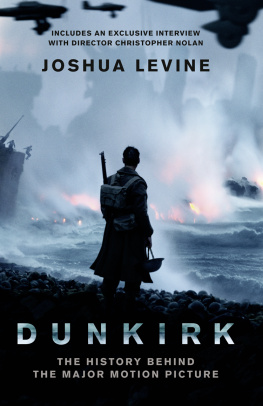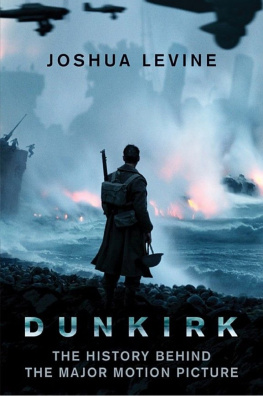William Collins
An imprint of HarperCollinsPublishers
1 London Bridge Street
London SE1 9GF
WilliamCollinsBooks.com
This eBook first published in Great Britain by William Collins in 2017
Copyright Joshua Levine 2017

Cover image copyright 2017 Warner Bros. Entertainment Inc.Copyright 2017 Warner Bros. Entertainment Inc. DUNKIRK and all related characters and elements are trademarks and Warner Bros. Entertainment Inc. WB SHIELD: and Warner Bros. Entertainment Inc. (S17)
Joshua Levine asserts the moral right to be identified as the author of this work
Map by John Gilkes
A catalogue record for this book is available from the British Library
Excerpt from The Road to Wigan Pier by George Orwell (Copyright George Orwell, 1937), reprinted by permission of Bill Hamilton as the Literary Executor of the Estate of the Late Sonia Brownell Orwell; (Victor Gollancz 1937, Martin Secker & Warburg 1959, Penguin Books 1962, 1989, Penguin Classics 2001). Copyright 1937 by Eric Blair. This edition copyright the Estate of the late Sonia Brownell Orwell, 1986; and Copyright 1958 and renewed 1986 by the Estate of Sonia B. Orwell, reprinted by permission of Houghton Mifflin Harcourt Publishing Company. All rights reserved.
All rights reserved under International and Pan-American Copyright Conventions. By payment of the required fees, you have been granted the non-exclusive, non-transferable right to access and read the text of this e-book on-screen. No part of this text may be reproduced, transmitted, down-loaded, decompiled, reverse engineered, or stored in or introduced into any information storage and retrieval system, in any form or by any means, whether electronic or mechanical, now known or hereinafter invented, without the express written permission of HarperCollins.
Source ISBN: 9780008227876
Ebook Edition June 2017 ISBN: 9780008227883
Version: 2017-05-22
To Lionel who inspired me.
To Peggy whom I hope to inspire.
To Philip Brown, Eric Roderick, Harold Vic Viner and Charlie Searle with thanks.
Contents
One afternoon, sitting in the National Archives in Kew, I opened a file containing a report by Commander Michael Ellwood. Commander Ellwood was in charge of communications during the Dunkirk evacuation, and he wrote, in passing, of a Marconi transmitter/receiver that was used for a very short time before it broke down due to sand in the generator.
This seemed surprising. How had sand got inside this precious piece of equipment? The Marconi TV5 was a sizeable box, and the memory of Laurel and Hardy delivering a piano in The Music Box flashed through my mind. Had two particularly clumsy ratings dropped it on the beach? Had Captain William Tennant, the Senior Naval Officer Dunkirk, yelled at them in frustration when they told him what they had just done to his only piece of transmitting equipment? Or did they stay quiet and hope that somebody else got the blame?
A short while later, in May 2016, I was standing at the shore end of the Dunkirk mole, very close to where Captain Tennant had placed his headquarters. Looking around, I could see parts of the Dunkirk beach cluttered with soldiers or men who looked like soldiers. There were warships out to sea, and a white hospital ship, clearly marked with red crosses, was berthed at the end of the mole. Black smoke billowed in the distance, and the sea frontage had been camouflaged to remove any traces of the late twentieth century. Dunkirk was looking remarkably as it had in late May 1940.
Something else was striking, though. The wind had picked up and sand was whipping everywhere. It was clogging hair and stinging eyes. Most people were wearing goggles and shielding their faces and I suddenly realised that nobody had dropped the transmitter. There had been no clumsy ratings. Sand had been blown into the generator in May 1940 just as it was now blowing into everybodys eyes and ears. By spending time at Dunkirk, I was learning things about the original event that I could simply never have learned otherwise.
This is why I would urge anybody interested in the story of the evacuation to visit Dunkirk. Walking along the beaches and up the mole, exploring the perimeter where French and British troops kept the Germans at bay, visiting the excellent War Museum, the deeply moving cemetery and glise Saint-loi with its bullet- and shrapnel-pitted walls these are all activities that will bring the events of May and June 1940 to life. The landscape retains the story, and fills in the gaps between words.
With this book, I have tried to tell a different story, or at least a wider story. Just as a visit to Dunkirk will make you think differently about the evacuation, so this book tries to explain events by placing them within a richer context not merely military, but also political and social. It will try to give a sense of what it was to be a young soldier in 1940, and of the importance of youth culture, in its different forms, in the build-up to war. It will focus on the fighting (and sometimes lack of fighting) that led to the evacuation. And it will explore the effect of the evacuation, up to its very latest manifestation the 2017 Chris Nolan film.
I have been lucky enough to work as historical adviser on this film. It was a pleasure to do so partly because I enjoyed meeting so many interesting and enthusiastic people. But mainly because it has brought an under-appreciated piece of history to life in a remarkable way. In the last chapter, you will read of the efforts taken by director, producer and heads of department to be as true as possible to the historical event. By making those efforts, they have allowed the spirit of the evacuation to be recreated as vividly and as truly as I think it ever could be. The result allows us to experience the story for what it actually was a hard and desperate fight for survival that kept the world free.
Nothing could be more important than that. I urge you to remember, as you watch, that without the real Tommys, Georges and Alexes, we would be living in a far darker world today. And many of us would not be living at all.
Joshua Levine
April 2017
An Interview between Joshua Levine and Director Christopher Nolan
Joshua Levine: Youre a British person who works in America. When you said you wanted to make this very British subject into a movie, what did people say?
Christopher Nolan: I had the script finished before I told anyone. Emma [Thomas producer of Dunkirk] knew. She had originally given me your book [Forgotten Voices of Dunkirk] to read. We had made a Channel crossing many years ago with a friend of ours (whos actually in the film in one of the boats) in the spirit of re-enacting that historic journey. It was one of the most difficult and frankly dangerous-feeling experiences I have ever had. I was very grateful to get back in one piece, and that was without people dropping bombs on us. It was literally just the Channel, the elements and the three of us on a small boat.
JL: And you made that crossing as an homage?
CN: Yes. We did it a little bit too early in the year. It was Easter, I think it was April rather than May. It was a little too cold and we went over to Dunkirk specifically, but not as massive history buffs. We knew the story we had grown up with it and our friend had a sail boat, and he said lets just do it. It turned out to be very, very difficult (at least for me and Emma) venturing out into the Channel in a small boat. Its a considerable thing to do. The idea of doing it and knowing that youre heading into a war zone is unthinkable really. And thats where the analysis of what Dunkirk means as mythology, or as modern mythology, or whatever you want to call it, cant be overstated. By actually getting on a boat and making that trip you can glimpse the bravery of the people who did it. Its just such a courageous thing for them to have done.


















